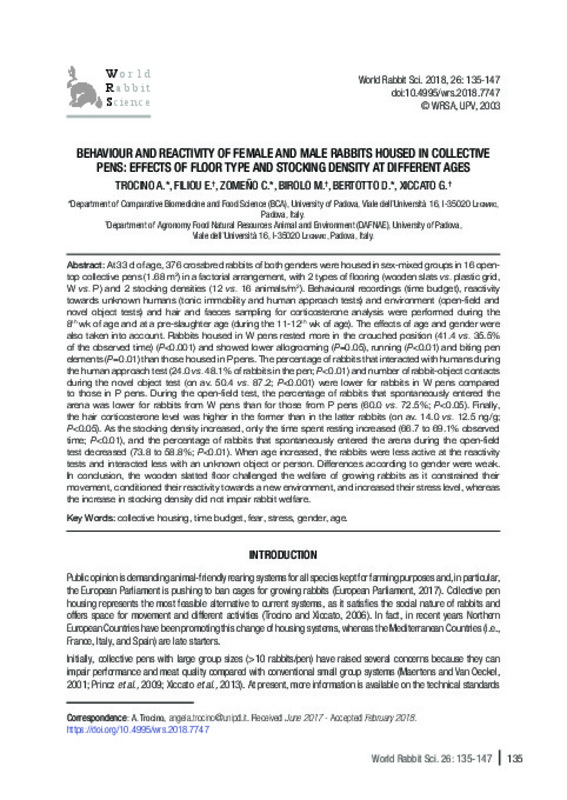JavaScript is disabled for your browser. Some features of this site may not work without it.
Buscar en RiuNet
Listar
Mi cuenta
Estadísticas
Ayuda RiuNet
Admin. UPV
Behaviour and reactivity of female and male rabbits housed in collective pens: effects of floor type and stocking density at different ages
Mostrar el registro sencillo del ítem
Ficheros en el ítem
| dc.contributor.author | Trocino, Angela
|
es_ES |
| dc.contributor.author | Filiou, Eirini
|
es_ES |
| dc.contributor.author | Zomeño, Cristina
|
es_ES |
| dc.contributor.author | Birolo, Marco
|
es_ES |
| dc.contributor.author | Bertotto, Daniela
|
es_ES |
| dc.contributor.author | Xiccato, Gerolamo
|
es_ES |
| dc.date.accessioned | 2018-06-29T10:45:00Z | |
| dc.date.available | 2018-06-29T10:45:00Z | |
| dc.date.issued | 2018-06-28 | |
| dc.identifier.issn | 1257-5011 | |
| dc.identifier.uri | http://hdl.handle.net/10251/104848 | |
| dc.description.abstract | [EN] At 33 d of age, 376 crossbred rabbits of both genders were housed in sex-mixed groups in 16 open-top collective pens (1.68 m2) in a factorial arrangement, with 2 types of flooring (wooden slats vs. plastic grid, W vs. P) and 2 stocking densities (12 vs. 16 animals/m2). Behavioural recordings (time budget), reactivity towards unknown humans (tonic immobility and human approach tests) and environment (open-field and novel object tests) and hair and faeces sampling for corticosterone analysis were performed during the 8th wk of age and at a pre-slaughter age (during the 11-12th wk of age). The effects of age and gender were also taken into account. Rabbits housed in W pens rested more in the crouched position (41.4 vs. 35.5% of the observed time) (P<0.001) and showed lower allogrooming (P=0.05), running (P<0.01) and biting pen elements (P=0.01) than those housed in P pens. The percentage of rabbits that interacted with humans during the human approach test (24.0 vs. 48.1% of rabbits in the pen; P<0.01) and number of rabbit-object contacts during the novel object test (on av. 50.4 vs. 87.2; P<0.001) were lower for rabbits in W pens compared to those in P pens. During the open-field test, the percentage of rabbits that spontaneously entered the arena was lower for rabbits from W pens than for those from P pens (60.0 vs. 72.5%; P<0.05). Finally, the hair corticosterone level was higher in the former than in the latter rabbits (on av. 14.0 vs. 12.5 ng/g; P<0.05). As the stocking density increased, only the time spent resting increased (66.7 to 69.1% observed time; P<0.01), and the percentage of rabbits that spontaneously entered the arena during the open-field test decreased (73.8 to 58.8%; P<0.01). When age increased, the rabbits were less active at the reactivity tests and interacted less with an unknown object or person. Differences according to gender were weak. In conclusion, the wooden slatted floor challenged the welfare of growing rabbits as it constrained their movement, conditioned their reactivity towards a new environment, and increased their stress level, whereas the increase in stocking density did not impair rabbit welfare. | es_ES |
| dc.description.sponsorship | This work was supported by the Seventh Framework Programme of the European Commission [grant number 600376, CUP C91J13001170006]. The authors wish to thank Dr. Andrea Zuffellato (AIA S.p.A., Italy) for his technical support and assistance. | es_ES |
| dc.language | Inglés | es_ES |
| dc.publisher | Universitat Politècnica de València | |
| dc.relation.ispartof | World Rabbit Science | |
| dc.rights | Reserva de todos los derechos | es_ES |
| dc.subject | Collective housing | es_ES |
| dc.subject | Time budget | es_ES |
| dc.subject | Fear | es_ES |
| dc.subject | Stress | es_ES |
| dc.subject | Gender | es_ES |
| dc.subject | Age | es_ES |
| dc.title | Behaviour and reactivity of female and male rabbits housed in collective pens: effects of floor type and stocking density at different ages | es_ES |
| dc.type | Artículo | es_ES |
| dc.date.updated | 2018-06-29T09:57:04Z | |
| dc.identifier.doi | 10.4995/wrs.2018.7747 | |
| dc.relation.projectID | info:eu-repo/grantAgreement/EC/FP7/600376/EU/PISCOPIA Programme/ | |
| dc.rights.accessRights | Abierto | es_ES |
| dc.description.bibliographicCitation | Trocino, A.; Filiou, E.; Zomeño, C.; Birolo, M.; Bertotto, D.; Xiccato, G. (2018). Behaviour and reactivity of female and male rabbits housed in collective pens: effects of floor type and stocking density at different ages. World Rabbit Science. 26(2):135-147. https://doi.org/10.4995/wrs.2018.7747 | es_ES |
| dc.description.accrualMethod | SWORD | es_ES |
| dc.relation.publisherversion | https://doi.org/10.4995/wrs.2018.7747 | es_ES |
| dc.description.upvformatpinicio | 135 | es_ES |
| dc.description.upvformatpfin | 147 | es_ES |
| dc.type.version | info:eu-repo/semantics/publishedVersion | es_ES |
| dc.description.volume | 26 | |
| dc.description.issue | 2 | |
| dc.identifier.eissn | 1989-8886 | |
| dc.contributor.funder | European Commission |








